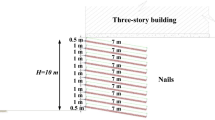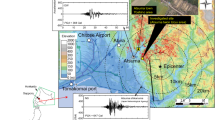Abstract
A series of large-scale shaking table tests were performed to investigate the damage mechanisms of a three-arch type subway station structure in a liquefiable soil experiencing strong motions. Methods to measure the displacement included the vision-based displacement test and the fiber Bragg grating test to measure the strain of the galvanized steel wire. Sand boils, waterspouts, ground surface cracks and settlements, and buoyancy movement of the model structure were observed. When the peak excess pore pressure ratios dramatically increased, the Arias intensity also dramatically increased. The peak acceleration of the model soil also almost coincided with liquefaction of the model soil. The seismic responses of the model structure and the soil were shown to be more sensitive to input motions with larger low-frequency components, the phenomenon of high frequency filtering and low frequency amplification effect of the liquefied soil were observed. The peak tensile strain located at the top and bottom of the center pillars was larger than that obtained at the subarch, while the peak tensile strain at the atrium arch was the smallest. The peak strain at the primary and secondary observation sections were remarkably affected by the spatial effect. The results can provide valuable insight into the seismic investigation of these subway structures.


































Similar content being viewed by others
References
An X, Shaww AA, Maekawa K (1997) The collapse mechanism of subway station during the Great Hanshin earthquake. Cem Concr Compos 19:241–257
Arias A (1970) Ameasure of earthquake intensity. In: Hansen RJ (ed) Seismic design for nuclearpower plants. MIT Press, Cambridge
Bennett MJ, McLaughlin PV, Sarmiento JS, Youd TL (1984) Geotechnical investigation of liquefaction sites. Imperial Valley, California. US Geological Survey, Open-File Report 84–252, 103 pp
Chen S, Chen G (2013) Vision-based dynamic displacement test software (version: 1.0). Software copyright in China. 2013SR022133. 2013-03-11
Chen GX, Zhang HY, Du XL et al (2007) Analysis of large-scale shaking table test of dynamic soil–subway station interaction. Earthq Eng Eng Vib 27(2):171–176 (in Chinese)
Chen G, Zuo X, Wang Z et al (2010a) Shaking table model test of subway station structure at liquefiable ground under far field and near field ground motion. J Zhejiang Univ Eng Sci 44(10):1955–1961 (in Chinese)
Chen G, Zuo X, Wang Z et al (2010b) Large scale shaking table test study of the dynamic damage behavior of subway station structure in liquefiable foundation under near-fault and far-field ground motions. China Civ Eng J 43(12):120–126 (in Chinese)
Chen G, Wang Z, Zuo X et al (2010c) Development of laminar shear soil container for shaking table tests. Chin J Geotech Eng 32(1):89–97 (in Chinese)
Chen G, Wang B, Sun T (2012) Dynamic shear modulus of saturated Nanjing fine sand in large scale shaking table tests. Chin J Geotech Eng 34(4):582–590 (in Chinese)
Chen G, Wang Z, Zuo X et al (2013) Shaking table test on the seismic failure characteristics of a subway station structure on liquefiable ground. Earthq Eng Struct Dyn 42:1489–1507
Han C (2011) Study on the response and design method of circular tunnel under severe earthquakes. Zhejiang University, Hangzhou (in Chinese)
Han X, Zuo X, Chen G (2010) 98 channels’ dynamic signal acquisition system development for shaking table test based on virtual instrument technology. J Disaster Prev Mitg Eng 30(5):503–508 (in Chinese)
Hashash Y, Hook J, Schmidt B, Yao J (2001) Seismic design and analysis of underground structures. Tunneling and Underground Space Technology 16:247–293
Holzer TL, Youd TL (2007) Liquefaction, ground oscillation, and soil deformation at the Wildlife Array, California. Bull Seismol Soc Am 97(3):961–976
Hyndmana RJ, Koehlerb AB (2006) Another look at measures of forecast accuracy. Int J Forecast 22:679
Iwatate T, Kobayashi Y, Kusu H et al (2000) Investigationand shaking table tests of subway structures of the Hyogoken-Nanbu earthquake. In: Proceedings of the 12WCEE
Kammerer AM, Wu J, Riemer MF, Pestana JM, Seed RB (2001) Use of cyclic simple shear testing in evaluation of the deformation potential of liquefiable soils. In: 4th internation conference on recent advances in geotechnical earthquake engineering, San Diego
Kattis SE, Beskos DE, Cheng AD (2003) 2D dynamic response of unlined and lined tunnels in poroelastic soil to harmonic body waves. Earthq Eng Struct Dyn 32(1):97–110
Koga Y, Matsuo O (1990) Shaking table tests of embankments resting on liquefaction sandy ground. Soils Found 30(4):162–174
Ling G, Shipei L, Juan N (2009) Damages of metro structures due to earthquake and corresponding treatment measures. Mod Tunnel Technol 46(4):36–41 (in Chinese)
Ling D-S, Guo H, Cai WJ et al (2012) Research on seismic damage of metro station with centrifuge shaking table model test. J Zhejiang Univ Eng Sci 10:1955–1961 (in Chinese)
Liu J, Liu X, Wang Z et al (2010) Dynamic centrifuge model test of a soil–structure interaction system. Chin J Civ Eng 43(11):114–121 (in Chinese)
Maymand PJ (1998) Shaking table scale model tests of nonlinear soil–pile–superstructure interaction in soft clay. University of California, Berkeley
Ohtomo K, Suehiro T, Kawai T et al (2001) Research on streamlining seismic safety evaluation of underground reinforced concrete duct-type structures in nuclear power stations—Part-2. Experimental aspects of laminar shear sand box excitation tests with embedded RC models. Transactions, SMiRT 16, Washington, DC, August 2001, Paper no. 1298
Ohtomo K, Suehiro T, Kawai T et al (2003) Substantial cross section plastic deformation of underground reinforced concrete structures during strong earthquakes. In: Proceedings of Japan Society of Civil Engineering, no. 724/I-62, pp 157–175 (in Japanese)
Samata S, Ohuch H, Matsuda T (1997) A study of the damage of subway structures during the 1995 Hanshin-Awaji earthquake. Cem Concr Compos 19:223–239
Schiff AJ (ed) (1998) Hyogoken-Nanbu (Kobe) earthquake of January 17, 1995 lifeline performance. Technical Council on Lifeline Earthquake Engineering Monograph, no. 14. ASCE
Sedarat H, Kozak A, Hashash YMA (2009) Contact interface in seismic analysis of circular tunnels. Tunn Undergr Space Technol 24:482–490
Seed HB, Lee KL (1966) Liquefaction of saturated sands during cyclic loading. J Soil Mech Found Eng ASCE 92:105–134
Tamari Y, Towhata I (2003) Seismic soil–structure interaction of cross sections of flexible underground structures subjected to soil liquefaction. Soil Found 43(2):69–87
Yasuda S, Harada K, Ishikawa K et al (2012) Characteristics of liquefaction in Tokyo Bay area by the 2011 Great East Japan earthquake. Soils Found 52(5):793–810
Acknowledgments
The authors gratefully acknowledge the financial support of this study by the Major Research Plan Integration Project of the Natural Science Foundation of China (No. 91215301) and the Project of Construction of Innovative Teams and Teacher Career Development for Universities and Colleges in the Beijing Municipality (No. IDHT20130512). Special thanks to the staff at Jiangsu Province Key Laboratory of Civil Engineering and Disaster Prevention and Mitigation, attached to the Nanjing University of Technology, and in particular to Mr. Xiaojian Han.
Author information
Authors and Affiliations
Corresponding author
Rights and permissions
About this article
Cite this article
Chen, G., Chen, S., Qi, C. et al. Shaking table tests on a three-arch type subway station structure in a liquefiable soil. Bull Earthquake Eng 13, 1675–1701 (2015). https://doi.org/10.1007/s10518-014-9675-0
Received:
Accepted:
Published:
Issue Date:
DOI: https://doi.org/10.1007/s10518-014-9675-0




